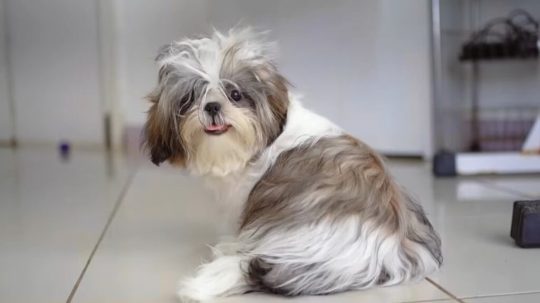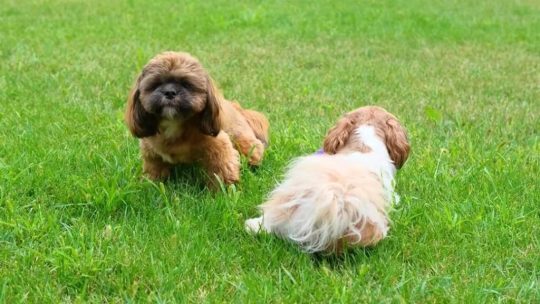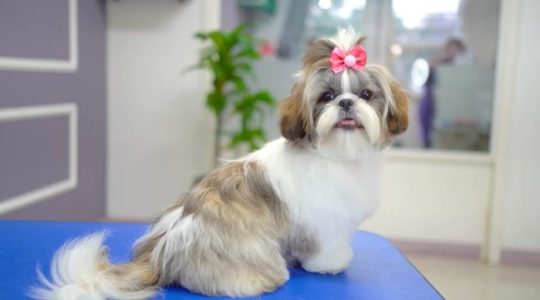#shihtzubehavior
Explore tagged Tumblr posts
Text
Living with a Shih Tzu Dog: A Guide to Laughter, Laps, and Long Hair

With lineage tucked into the chilly Tibetan mountains 2,000 years back, the signature double coat of the Shih Tzu dog was likely a cozy adaptation. Appreciated for their warmth, these mini creatures kept Chinese emperor’s toes toasty at bedtime. Bred by royal dog whisperers, the Shih Tzu’s roots are thought to weave together the Lhaso Apso and Pekingese. Crossing the pond in 1928, they’ve since charmed their way into becoming one of the most popular toy dogs in the US and UK. Let’s dive into the unique aspects of the Shih Tzu’s realm. Origin and Evolution Evolutionary History In conjunction with Shih Tzu origin, most evidence points to Tibet, where they’re bred by monks around 2,000 years back in time. As per some genetic studies, their strong relationships with the Lhasa Apso and Pekingese, proposing potential cross-breeding or shared root within ancient Tibetan “Lion Dogs.” Shih Tzu, esteemed by Chinese emperors from the Tang Dynasty forward, were pampered palace residents, with the Dowager Empress Cixi (1861-1908) being a prominent patron. Genetic Composition and Diversity While some concerns are present pertaining to potential health issues interlinked with brachycephaly, studies propose moderate to high genetic diversity within the breed. Environmental Adaptations The Shih Tzu’s double coat, in the annals of time, an adaptation to the harsh Tibetan climate, now offers warmth and shield in distinct environments. The shortened muzzle of the dog can result in breathing difficulties in hot or humid weather. Concerning Shih Tzu adaptations, they’re astonishingly adaptable to different living situations albeit their royal heritage. Distribution and Population Geographic Range When it comes to the Shih Tzu distribution, they sport immense popularity in the US, ranking in the top 20 most popular breeds as per the American Kennel Club (AKC) in 2023. Moving to Europe, the UK and France set the pace with significant Shih Tzu populations. Notwithstanding the fact that the breed’s roots lie in China, they’ve conquered the hearts of dog lovers across Asia, with prosperous populations in Taiwan, Japan and South Korea. Population Dynamics Albeit these cute creatures aren’t the fastest-growing breed, their population has typically encountered a steady boost in recent years, mirroring their lasting popularity. Types of Shih Tzu

Though major kennel clubs, like the American Kennel Club, recognize solely one breed of Shih Tzu dog, there’re distinct varieties with respect to size, coat color and markings. Let’s dig deep into the Shih Tzu’s types. By Size Standard Shih Tzu – the most common type of Shih Tzu, recognized by the AKC and weighing between 9 and 16 pounds. In addition, they measure about 9 to 11 inches in height. Imperial Shih Tzu – not an official AKC breed – is a smaller version of the standard Shih Tzu, normally weighing less than 9 pounds and standing around 8 inches. Teacup Shih Tzu – even smaller than Imperial Shih Tzus, weigh no more than 4 pounds and measure less than 6 inches in height. Nonetheless, owing to their small size, these the pups are most often than not prone to health problems. By Coat Color Solid-colored Shih Tzus come in a plethora of colors, such as black, white, brown, gold and brindle. Bi-colored Shih Tzus possess two different coat color, including black and white, brown and white or gold and white. Parti-colored Shih Tzus have three or more colors in their coat. By Markings Mask Shih Tzu: Some Shih Tzu varieties sport a darker marking on their face that’re identical to a mask. Brindle Shih Tzu: These varieties have a coat with two or more colors that’re streaked or brindled together. Piebald Shih Tzu: It has large patches of white on its coat, coupled with other colors. 5 Shih Tzu Facts In Tibetan monasteries, Shih Tzu were in times past guard dogs. Chinese emperors used to dote on these cute creatures, even sleeping parallel to them in elaborate “dog beds” within the palace. The havoc of China’s 20th century just about wiped out these lovable friends. It were the dedicated Shih Tzu dog breeders who brought them back from the edge. Their unparalleled jaw structure implies they smile even when grumpy! The luxurious coat of the Shih Tzu dog may stun you, but it grows like crazy, making daily brushing essential. Appearance

Physical Characteristics Size: Speaking of the Shih Tzu size, they stand at 8 to 11 inches at the shoulder and weigh in at 9 to 16 pounds. Shape: These compact and sturdy little dogs’ bodies are rather longer than they’re tall, with a level back and a rounded chest. Coat: Concerning the Shih Tzu coat, undoubtedly it’s the most striking feature it has – the long flowing double coat. The luxurious fur of Shih Tzu dog showcasing a spectrum of colors, including black, white brown, red, bridle, gold and even parti-colors and tri-colors. Life Cycles

Reproductive Biology In line with other dog breeds, the Shih Tzu dog is seasonal breeder, generally coming into heat twice a year, approximately 6 months apart. This “heat” period – when female Shih Tzu are receptive to mating – persists around 18 to 21 days. In terms of Shih Tzu litter size, they produce 3 to 5 puppies in average. There's also a mashup of the Bichon Frise and Shih Tzu, giving rise to a cute teddy bear dog known as Zuchon. Gestation Period The moment breeding takes place, the magic of pregnancy takes hold. The Shih Tzu gestation period normally holds up around 58 to 63 days. Life Cycle Stages Neonatal Stage: At this stage, from 0 to 2 weeks, pups are holistically rely on their mother for milk and warmth. Puppyhood: This energetic stage, from 2 weeks to 1 year, is characterized by swift growth, developing motor skills and learning social behaviors. Adulthood: This is the stage, from 1 to 6 years, where these cute creatures touch physical and sexual maturity. Seniority: When Shih Tzu age stepped into 6+ years, they become calmer and may entail less exercise. Nonetheless, they still crave affection and attention. Shih Tzu Lifespan This toy dog, renowned for its long, flowing coat and mischievous personality, enjoys a lifespan of 10 to 18 years. Astonishingly, a Florida Shih Tzu dog called Smokey holds the record for the oldest of its kind, having lived 23 years. Shih Tzu Dog Diet

As for as Shih Tzu diet is concerned, they entail high-quality protein, healthy fats, and easily digestible carbohydrates to fuel their mischievous personalities. Here’s a dissection of the core nutrients: Protein Maintain approximately 25 to 30% protein content in their diet as it assists in building and maintain muscle mass, which is ultimately pivotal for keeping them active. Sources of protein can encompass lamb, chicken, beef, fish or eggs. Fats It’s the healthy fats that offer energy and let your Shih Tzu pet absorb needed vitamins and minerals. Aim for the Shih Tzu dog food that comprises omega-3 and omega-6 fatty acids – beneficial for coat and skin health. Carbohydrates Carbohydrates, undoubtedly, offer energy, but they should be confined in a Shih Tzu’ diet. Opt for intricate carbohydrates such as whole grains, sweet potatoes or brown rice over simple carbohydrates like corn syrup or white flour. Cultural Significance and Symbolism Since the Tang Dynasty (618-907 AD), their pampered lives infused them with regal symbolism in Chinese palaces. They’re regarded as guardians of the emperor’s fortune and happiness. Honored in Tibetan monasteries, these toy dogs were thought to manifest the souls of monks. Their existence signified good luck and spiritual purity. Shih Tzu as Pets

Temperament In conjunction with the Shih Tzu temperament, they prioritize the cozy confines of home. They’re both stubbornly independent and affectionate, requiring attention with an endearing, if once in a blue moon insistent, charm. You’re to breed merely for companionship for they lack the instincts for guarding or hunting. The very undivided focus can reflect as a severe yearn for attention. The irresistible urge to be a lap dog is among their conspicuous traits, basking in the warmth of human company. In addition, they’re relatively quiet – another delightful characteristic – making them adaptable to a plenty of living situations. Maintenance Speaking of the Shih Tzu maintenance, they entail regular baths for hygiene and comfort. Ensure a monthly bath or every 3-4 weeks, built upon their activity level. Notwithstanding the coat length, Shih Tzu grooming is pivotal on daily basis. The long-haired companions entail daily attention to prevent matting, while medium-length fur requires brushing every other day. Exercise Despite their energetic personalities, adult Shih Tzu are gratified with moderate exercise. They’ll readily frolic in the house or yard – their mischievous bursts fueled by daily walks. In terms of the Shih Tzu exercise, schedule two outings a day, each lasting 20-30 minutes to keep them physically and mentally fired up. Training Since their independent streak can surface later on, kicking off the Shih Tzu training early is essential. They’re most often than not titled “stubborn” in terms of housebreaking, so positive, consistent reinforcement techniques are key. Albeit they can learn striking tricks, note that they do march to the beat of their own drum. Here, enticing snacks can work wonders as motivators to make them learn new skills and master desired behaviors. Care The Shih Tzu adoption, certainly, brings immense joy, but also necessitates awareness – on the part of the owners - of their unparalleled needs, expressly Shih Tzu puppies. Their striking double coat demands regular brushing and grooming. Hold daily sessions with the right tools – consider fine-toothed combs and gentle brushes – to maintain that luscious fur. Common Health Issues Brachycephalic Syndrome: Owing to flat face, breathing difficulties, conceivably entailing surgery. Eye Issues: Irritation from fur resulting in discomfort, treated with vet-prescribed eye drops. Ear Infections: Recurrent due to floppy ears, needing regular cleaning and vet attention. Intervertebral Disk Disease: Spinal issues frequent in toy breeds, affecting mobility. Hypothyroidism: Thyroid disorder in middle-aged dogs, treated with medication. Dental Problems: Higher tendency relative to other breeds, entailing consistent care. FAQs Are Shih Tzu aggressive? Generally speaking, Shih Tzus are not hostile toward strangers or young kids. They are an adorable dog breed that is well-known for being gregarious, sociable, and loving. Are Shih Tzu hypoallergenic? Yes, they are as hypoallergenic as dogs come, because they don't shed much. With a Shih Tzu, people who are allergic to fur might be okay. Are Shih Tzu smart? Shih Tzus are generally thought of as intelligent dogs, and they have even helped craftsmen and farmers in the past. Are Shih Tzu easy to train? They are eager to learn new skills and are quite trainable, yet they pick up new skills far more quickly than their owners do. Are Shih Tzu good dogs? Shih Tzu are known for having lively, joyful dispositions. They are gregarious and energetic. Can Shih Tzu eat banana? Although they might be a nutritious supplement to a Shih Tzu diet, bananas shouldn't take the place of a well-balanced diet. Read the full article
#shihtzuadoption#shihtzuage#shihtzuanatomy#shihtzubehavior#shihtzucare#shihtzucolor#shihtzudiet#shihtzudog#shihtzudogfood#shihtzufacts#shihtzulifespan#shihtzuorigin#shihtzusize#shihtzutemperament
0 notes